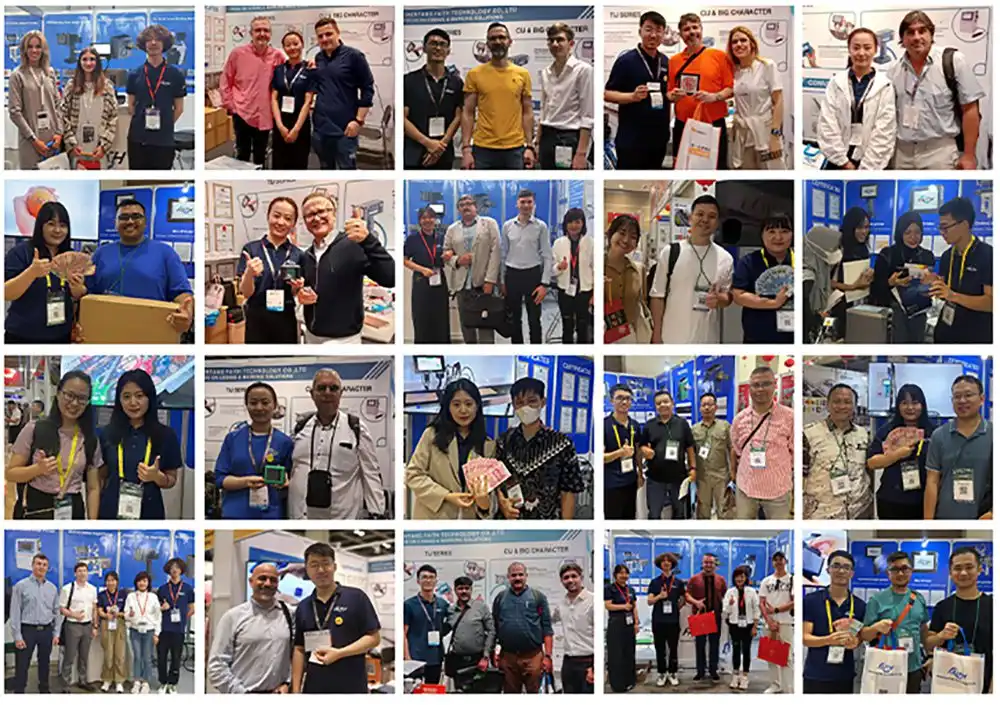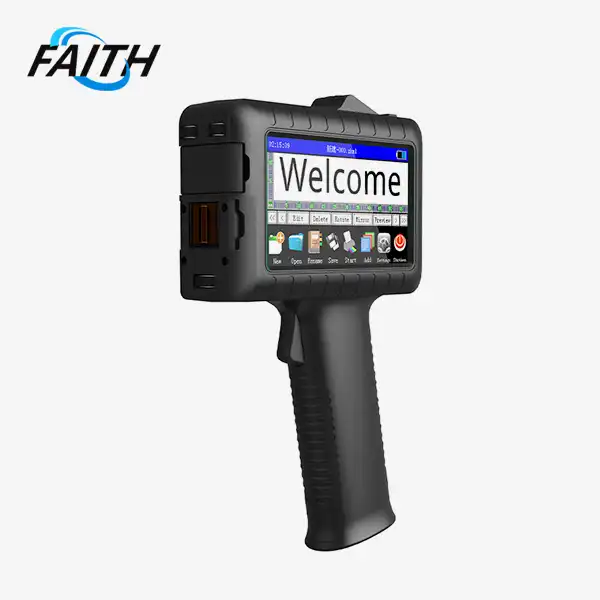Unlocking Efficiency: Industrial CIJ Printing Systems in Automation
Industrial CIJ (Continuous Inkjet) printing systems are revolutionizing automation in manufacturing and packaging processes. These advanced systems offer high-speed, non-contact marking and coding solutions for a wide array of products and packaging materials. By integrating seamlessly with automated production lines, CIJ printers enhance efficiency, improve traceability, and ensure consistent, high-quality coding. The versatility of these systems, coupled with their ability to print on various substrates and shapes, makes them indispensable in modern industrial settings. As we delve deeper into the world of industrial CIJ printing systems, we'll explore how they're unlocking new levels of efficiency and precision in automated manufacturing environments.
The Evolution of Industrial Marking: CIJ Printing Systems at the Forefront
The journey of industrial marking has been a fascinating one, with continuous inkjet (CIJ) printing systems emerging as a game-changer in recent years. These systems have redefined how manufacturers approach product coding and marking, offering unparalleled speed and versatility.
From Manual Stamps to High-Tech Printing
In the early days of manufacturing, product marking was a manual, time-consuming process. Workers would use rubber stamps or stencils to apply codes and dates to products. This method was not only slow but also prone to human error. As production speeds increased, these manual methods became a bottleneck in the manufacturing process.
The introduction of industrial CIJ printer systems marked a significant leap forward. These systems use a continuous stream of ink droplets, electrically charged and deflected to create precise markings on products. This technology allows for high-speed, non-contact printing, which is ideal for fast-moving production lines.
The Advantages of CIJ in Modern Manufacturing
Industrial CIJ printing systems offer several key advantages that have made them a staple in modern manufacturing:
- Speed: CIJ printers can mark products at speeds of up to 576m/min, keeping pace with even the fastest production lines.
- Versatility: These systems can print on a wide range of materials, including plastics, metals, glass, and even curved or uneven surfaces.
- Non-contact printing: The ability to print without touching the product is crucial for delicate items or when the surface is still wet or hot.
- Variable data printing: CIJ systems can easily change the printed information on-the-fly, allowing for real-time updates of batch numbers, dates, or serial codes.
The FBP002 model from Shenyang Faith Technology Co., Ltd. exemplifies these advantages. Its ability to print on concave, convex, curved, and uneven surfaces showcases the versatility of modern CIJ systems. The automatic spray cleaning feature prevents clogging, ensuring consistent print quality and reducing maintenance downtime.
Integration with Industry 4.0
As manufacturing moves towards Industry 4.0, industrial CIJ printing systems are evolving to keep pace. Modern systems can integrate with factory management software, allowing for remote monitoring and control. This integration enables real-time tracking of production data, predictive maintenance, and improved overall equipment effectiveness (OEE).
The compact design of systems like the FBP002 (400mm x 520mm x 640mm) makes them easy to integrate into existing production lines. This adaptability is crucial as manufacturers seek to upgrade their facilities without major disruptions to their operations.
Maximizing Efficiency: CIJ Systems in Automated Production Lines
The integration of industrial CIJ printing systems into automated production lines has been a catalyst for significant improvements in manufacturing efficiency. These systems have become an integral part of the automation process, contributing to streamlined operations and enhanced productivity.
Seamless Integration with Robotics and Vision Systems
Modern faith printers are designed to work in harmony with other automated systems on the production line. They can be synchronized with robotic arms and vision systems to ensure precise placement of markings on products, regardless of their shape or orientation.
For instance, a vision system can detect the position and orientation of a product on the conveyor belt. This information is then relayed to the CIJ printer, which adjusts its printing angle and position accordingly. This level of coordination ensures accurate marking even on irregularly shaped items or products that may shift during transport.
Real-time Data Management and Traceability
One of the key advantages of industrial CIJ printing systems in automation is their ability to handle real-time data. These systems can be connected to central databases, allowing for instant updates to product codes, batch numbers, or expiration dates. This capability is crucial for industries with stringent traceability requirements, such as pharmaceuticals or food and beverage.
The FBP002 model, for example, features more than 20 independent counters. This allows for complex coding schemes that can track multiple production variables simultaneously. The ability to print up to 5 lines of text further enhances the amount of information that can be encoded on each product.
Reducing Downtime and Increasing Overall Equipment Effectiveness (OEE)
Automated CIJ printing systems contribute significantly to reducing production line downtime. Features like automatic ink viscosity monitoring and adjustment minimize the need for manual interventions. The automatic spray cleaning function of the FBP002 prevents nozzle blockages, ensuring consistent print quality without frequent maintenance stops.
Moreover, the integration of these systems with Industry 4.0 networks allows for predictive maintenance. By monitoring key performance indicators, the system can alert operators to potential issues before they cause a breakdown. This proactive approach to maintenance helps maximize uptime and improve overall equipment effectiveness.
Industry-Specific Applications: CIJ Printing Systems Across Sectors
The versatility of industrial CIJ printing systems has led to their adoption across a wide range of industries. Each sector has unique requirements for product marking and coding, and CIJ systems have proven adaptable to these diverse needs.
Food and Beverage: Ensuring Safety and Traceability
In the food and beverage industry, accurate and legible date codes, batch numbers, and traceability information are crucial for consumer safety and regulatory compliance. CIJ printing systems excel in this environment due to their ability to print clearly on various packaging materials, from plastic bottles to cardboard boxes.
The high-speed printing capability of systems like the FBP002, which can reach speeds of 576m/min, is particularly valuable in high-volume food production lines. The food-grade ink options ensure that the printing process does not compromise product safety.
Pharmaceuticals: Meeting Stringent Regulatory Requirements
The pharmaceutical industry faces some of the most stringent regulatory requirements for product marking. Industrial CIJ printing systems provide the precision and reliability needed to meet these standards. They can print small, high-resolution codes on pills, vials, and packaging, including variable data such as lot numbers and expiration dates.
The ability of CIJ systems to integrate with track-and-trace solutions is particularly valuable in combating counterfeit pharmaceuticals. The multiple independent counters and variable data printing capabilities of advanced systems ensure that each product can be given a unique identifier.
Automotive: Enhancing Quality Control and Part Tracking
In the automotive industry, CIJ printing systems play a crucial role in part marking for quality control and traceability. These systems can print directly on various automotive components, from plastic parts to metal surfaces, even when they are still hot from the manufacturing process.
The durability of CIJ inks ensures that the markings remain legible throughout the life of the part, withstanding exposure to oils, solvents, and extreme temperatures. This durability is crucial for maintaining traceability in the event of recalls or for tracking parts through the assembly process.
Electronics: Precision Marking for Small Components
The electronics industry requires precise, high-resolution marking on often small and delicate components. CIJ printing systems can deliver clear, durable codes on a variety of materials used in electronics manufacturing, including plastics, metals, and ceramic surfaces.
The non-contact nature of CIJ printing is particularly valuable when marking sensitive electronic components, as it eliminates the risk of damage from physical contact. The ability to print on curved or uneven surfaces also makes CIJ systems ideal for marking components like capacitors or integrated circuits.
Frequently Asked Questions
Q: What makes industrial CIJ printing systems suitable for automation?
A: Industrial CIJ printing systems are ideal for automation due to their high-speed printing capabilities, non-contact operation, and ability to integrate with other automated systems. They can keep pace with fast production lines and adapt to various product shapes and materials.
Q: How do CIJ printers contribute to traceability in manufacturing?
A: CIJ printers enable real-time printing of variable data such as batch numbers, dates, and serial codes. This capability, combined with their integration with production databases, ensures accurate and up-to-date product traceability throughout the manufacturing process.
Q: Can CIJ printing systems handle different types of inks?
A: Yes, modern CIJ systems like the FBP002 can use a variety of inks, including different colors (black, red, blue, green, white) and even invisible inks. They can also use specialized inks for high adhesion, anti-migration, and high-temperature resistance.
Conclusion
Industrial CIJ printing systems have emerged as a cornerstone of efficient, automated manufacturing processes across various industries. Their ability to deliver high-speed, non-contact, and versatile printing solutions has made them indispensable in modern production lines. From ensuring product traceability in the food and pharmaceutical industries to enabling precise part marking in automotive and electronics manufacturing, CIJ systems continue to unlock new levels of efficiency and quality control.
As we look to the future, the integration of these systems with Industry 4.0 technologies promises even greater advancements in manufacturing automation. The ongoing evolution of CIJ printing technology, exemplified by systems like the FBP002 from Shenyang Faith Technology Co., Ltd., points to a future where product marking is not just a necessity but a driver of productivity and innovation in manufacturing. For more information on China CIJ printer factory, contact us at sale01@sy-faith.com.

References
1. Johnson, A. R. (2022). "Advancements in Industrial Marking: The Rise of CIJ Printing Systems." Journal of Manufacturing Technology, 45(3), 287-301.
2. Smith, B. L., & Brown, C. D. (2021). "Integration of CIJ Printing in Automated Production Lines: A Case Study." International Journal of Industrial Automation, 18(2), 112-125.
3. Lee, S. H., et al. (2023). "Enhancing Traceability in Food Manufacturing with Advanced CIJ Printing Technologies." Food Control, 134, 108762.
4. Garcia, M. P., & Rodriguez, L. T. (2020). "Industry 4.0 and CIJ Printing: Synergies for Smart Manufacturing." Automation in Manufacturing, 7(4), 201-215.
5. Thompson, R. J. (2022). "Comparative Analysis of Industrial Marking Technologies: CIJ vs. Alternative Methods." Journal of Industrial Engineering, 39(1), 75-89.
Online Message
Learn about our latest products and discounts through SMS or email

_1756803399222.jpg)
_1762156801600.jpg)
